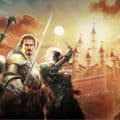Perhaps the single biggest influence on modern board gaming was the Franco-Prussian War. Watch the video to find out why.
Video Transcript
War and games have always been linked. Children have have pretended sticks were swords for as long as swords have existed. Ancient Greek military training lead to the Olympic Games. Medieval European cavalry training gave way to jousting tournaments. Paintballing and first person shooters are two modern takes on war as a game, both of which are used to this day to train soldiers for combat.
There is a strong link between war and play. Perhaps one of the weirder results of this link is how actual wars have played a bigger role in shaping modern board gaming than perhaps anything else.
Johann Christian Ludwig Hellwig was a college professor in Prussia in 1780, and he is considered the father of wargaming. Because many of his students were destined to become military leaders, he wanted to create a game that could teach his students practical military lessons. And thus wargaming was invented.
But some of the most ancient games are about war, like go and chess, so what made Hellwig’s new war game different? It was played on a grid, like its ancient counterparts. It consisted of capturing your opponent’s pieces, too. And it was even invented to teach war to future military leaders, just like its ancient counterparts.
So what made this game so different?
Well, the biggest innovation was Hellwig’s move away from abstractness: Hellwig’s pieces represented real types of military units, with realistic movement speeds relative to their real world counterparts. They were limited by different types of terrain, each with its own properties limiting movement, color coded on the map, all based on real world military considerations. Swamps slowed down units, rivers could only be crossed with the aid of a specific type of unit, etc. Pieces could get flanked since they could only face on direction at a time, and artillery units could capture pieces from a distance by shooting at them in lieu of moving.
In a word, he made his game more thematicly representative of real warfare.
Up until this point, games for the most part, have had very simple rules. Adding complexity to simulate real world complications was a completely novel idea at the time. And eventually, this idea would catch on in a big way in the world of hobby board games.
But wargaming didn’t catch on initially, at least, not outside of Prussia’s military, where it became a standard part of their military training. It wasn’t until Prussia defeated France in the Franco-Prussian War, nearly a hundred years after Hellwig’s game was designed that that began to change. The Prussians were outmatched in every way against France, and the popular explanation at the time was that the Prussians were only able to defeat France because they had developed these games that made them into superior tacticians.
And since the Treaty of Versailles restricted Germany’s actual military exercises, it quickly became popular in the German military too. Wargaming also became popular in the British, US, and Japanese militaries too.
From there, it spread to civilian populations too, getting the most popular in Germany.
It would be nearly another hundred years until the next important innovation in board gaming happens. After loosing World War II, the German appetite for war-games dwindled quickly. There was a national sense of shame that found no joy in war games. The British and US occupation even had a shame campaign “These Atrocities: Your Fault!” War-games quickly became very niche.
Since these complex war games were so popular, it was only a matter of time until something new filled its spot. It was just a matter of answering what?
In 1964, when the game Acquire was published, they found that answer. The Eurogame. It was the first game that kept some of the complexity from war-games, but it discarded the direct conflict and the thematic realism that war-games chased after. The game had all the hallmarks of the modern Eurogame: little direct conflict, a focus on resources and building things, a theme that’s secondary to its mechanics, and no player elimination. All of these in contrast to the war-games that had come before it.
It was perfect for the moment, and the ideas behind its design caught on. Germany had been in the middle of reconstructing its country after the fallout from WWII, and this new genre of game tapped into their collective desire to build rather than destroy.
Meanwhile, in America, wargames remained popular. American wars had only managed to increase American patriotism and nationalism, and war remained a far-off idea for most Americans, . So when the Cold War began, it only managed to make war-games more popular.
In fact, all through the 20th century, wargaming only got more and more popular.
Back in the early 20th century, The Landlord’s Game, which later got republished as Monopoly, was among the earliest non-war-centric games to take the theme-first approach pioneered by war-games. In many ways, it was the perfect embodiment of what Ameritrash would later become known for: cutthroat player elimination, theme first design, and long play times. Still, this game serves as an almost perfect foil for Acquire, another game about building hotels where the richest player wins.
It’s easy to see how war-games lead to modern Ameritrash, simply because there was never a revolution: war-games stayed popular and evolved to meet trends slowly. When dice were introduced, other games followed suit. When Dungeons and Dragons became popular, so did fantasy war-games. It wasn’t until 1995, when Settlers of Catan took America by storm, that Ameritrash games began to significantly change.
Just like America’s stance on war has shifted very little, America’s stance on war-games has stayed the same.
Of the two major genres of board games, both of them have clear historical connections to war. Both of them were born as a response to war.
It’s odd to think that board gaming, something so distinct from war, can be so distinctly shaped by it.
If you enjoyed the video, please consider liking and subscribing. Thanks.

